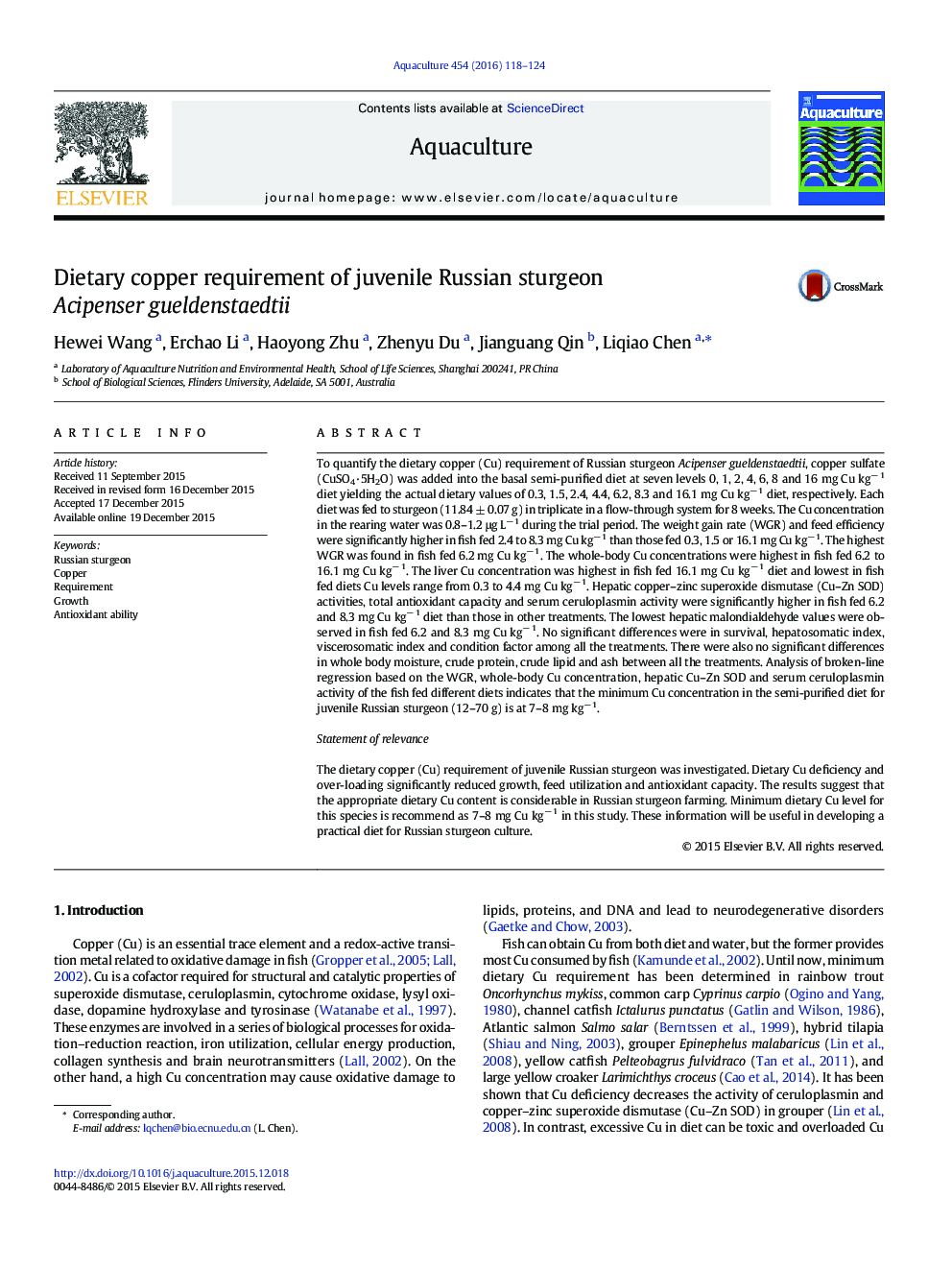| کد مقاله | کد نشریه | سال انتشار | مقاله انگلیسی | نسخه تمام متن |
|---|---|---|---|---|
| 2421499 | 1552833 | 2016 | 7 صفحه PDF | دانلود رایگان |

• Dietary Cu requirement of juvenile Russian sturgeon was studied.
• Dietary Cu is essential for the growth of juvenile Russian sturgeon.
• Dietary Cu deficiency and over-loading lead to poor growth and antioxidant capacity.
• The minimum dietary Cu level for juvenile Russian sturgeon is 7–8 mg Cu kg− 1.
To quantify the dietary copper (Cu) requirement of Russian sturgeon Acipenser gueldenstaedtii, copper sulfate (CuSO4·5H2O) was added into the basal semi-purified diet at seven levels 0, 1, 2, 4, 6, 8 and 16 mg Cu kg− 1 diet yielding the actual dietary values of 0.3, 1.5, 2.4, 4.4, 6.2, 8.3 and 16.1 mg Cu kg− 1 diet, respectively. Each diet was fed to sturgeon (11.84 ± 0.07 g) in triplicate in a flow-through system for 8 weeks. The Cu concentration in the rearing water was 0.8–1.2 μg L− 1 during the trial period. The weight gain rate (WGR) and feed efficiency were significantly higher in fish fed 2.4 to 8.3 mg Cu kg− 1 than those fed 0.3, 1.5 or 16.1 mg Cu kg− 1. The highest WGR was found in fish fed 6.2 mg Cu kg− 1. The whole-body Cu concentrations were highest in fish fed 6.2 to 16.1 mg Cu kg− 1. The liver Cu concentration was highest in fish fed 16.1 mg Cu kg− 1 diet and lowest in fish fed diets Cu levels range from 0.3 to 4.4 mg Cu kg− 1. Hepatic copper–zinc superoxide dismutase (Cu–Zn SOD) activities, total antioxidant capacity and serum ceruloplasmin activity were significantly higher in fish fed 6.2 and 8.3 mg Cu kg− 1 diet than those in other treatments. The lowest hepatic malondialdehyde values were observed in fish fed 6.2 and 8.3 mg Cu kg− 1. No significant differences were in survival, hepatosomatic index, viscerosomatic index and condition factor among all the treatments. There were also no significant differences in whole body moisture, crude protein, crude lipid and ash between all the treatments. Analysis of broken-line regression based on the WGR, whole-body Cu concentration, hepatic Cu–Zn SOD and serum ceruloplasmin activity of the fish fed different diets indicates that the minimum Cu concentration in the semi-purified diet for juvenile Russian sturgeon (12–70 g) is at 7–8 mg kg− 1.Statement of relevanceThe dietary copper (Cu) requirement of juvenile Russian sturgeon was investigated. Dietary Cu deficiency and over-loading significantly reduced growth, feed utilization and antioxidant capacity. The results suggest that the appropriate dietary Cu content is considerable in Russian sturgeon farming. Minimum dietary Cu level for this species is recommend as 7–8 mg Cu kg− 1 in this study. These information will be useful in developing a practical diet for Russian sturgeon culture.
Journal: Aquaculture - Volume 454, 1 March 2016, Pages 118–124